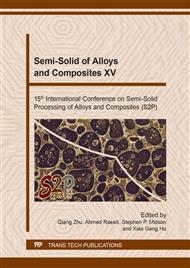p.197
p.203
p.210
p.219
p.224
p.234
p.240
p.247
p.253
Influence of Pouring Temperature and Alloy Additions on the Quality of a Semisolid Material Dragged during the Continuous-Casting Strip Processing of Al–Si A413
Abstract:
Al–Si A413 treated and untreated alloys were cast and poured at approximately 720 oC, 700 oC, and 680 oC in a cooling slope to obtain the semisolid material feeding the ceramic nozzle (150 cm3) at the lower roll (single-roll melt-dragged processing)—this drags the metallic slurry via the chill/columnar layers at a rate of 0.2 m/s, forming a molten-metal strip with a thickness of 2 mm and width 45 mm, approximately. The untreated alloy poured at 720 oC formed coarse structures of α-Al dendrites, as well as a coarse eutectic of Al–Si and microshrinking on the surface of the casting strip facing the atmosphere. The Al–Si 413 alloy poured at 680 oC and treated with Al5Ti1B (0.1%) led to microstructural refinement, resulting in α-Al globular structures, the absence of microporosities on the surface facing the atmosphere, and a finer and more homogeneous distribution of the eutectic grains with smaller Si particles. The AlTiB master alloys are not used as a grain refiner in Al–Si alloys because of Si poisoning. This subject is discussed in this paper. The addition of the inoculant and 0.2% of the Al–Si eutectic morphology modifying agent (Al–10%Sr) refined both the α-Al and eutectic phases more efficiently in the cast strip poured at 700 oC and 680 oC. This suggests that the inoculant did not interfere with the action of the modifying agent. As a result, molten metal strips of higher mechanical strengths and ductilities were obtained.
Info:
Periodical:
Pages:
224-233
Citation:
Online since:
January 2019
Keywords:
Price:
Сopyright:
© 2019 Trans Tech Publications Ltd. All Rights Reserved
Share:
Citation:


